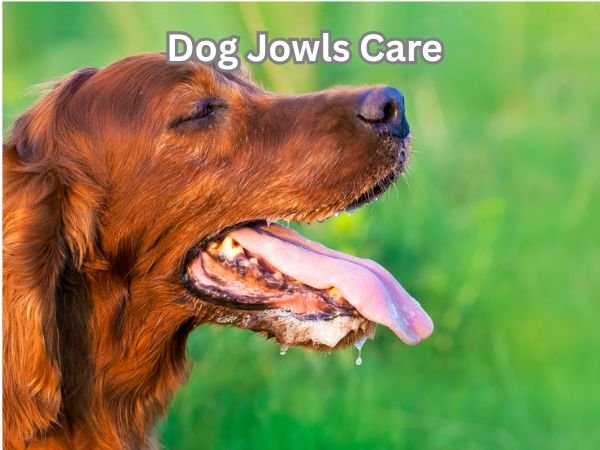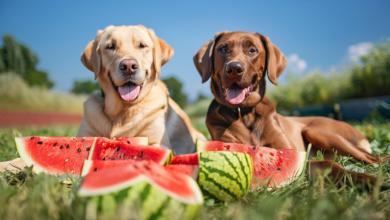
Taking care of your dog’s jowls is an essential part of keeping them healthy and comfortable. Dog jowls—the loose, sometimes droopy skin around their mouths—play important roles, from helping with eating to protecting their facial area. However, these folds can also trap moisture and debris, making proper cleaning and care vital. Good dog jowls care not only prevents infections but also promotes overall dog facial hygiene and skin health, ensuring your furry friend feels their best.
With the right knowledge and routine, you can help your pup avoid discomfort and stay vibrant. In this article, discover five must-know tips that make dog jowls care simple and effective for a happier, healthier companion.
What Are Dog Jowls?
Dog Jowls Care- Dog jowls are the loose, floppy folds of skin and tissue hanging around the sides of your dog’s mouth. While all dogs have jowls to some degree, they’re much larger in breeds like Bulldogs, Mastiffs, and Bloodhounds. Jowls help dogs with vital tasks—like carrying objects or even cooling off through drooling!
Why Do Dog Jowls Need Special Care?
Those adorable jowls come with their own set of challenges. Here’s why they need special attention:
- Drooling: Jowls act like little reservoirs for drool. Some breeds drool a lot, which can make jowls damp most of the day. Constant moisture leads to irritation or even “dog drooling causes” bad smells.
- Bacterial Accumulation: All that extra skin can trap food, dirt, and saliva. This is a cozy home for bacteria and yeast.
- Dog Jowl Infections: If not cleaned regularly, jowls can get red, inflamed, or even infected. Signs of dog jowl infections include bad odor, swelling, sores, or discharge.
Common Issues with Dog Jowls
- Chronic Drooling: Some breeds naturally drool more, especially after drinking or eating—a normal “dog drooling cause.”
- Skin Fold Dermatitis: Moisture and bacteria stuck in folds can cause redness and irritation.
- Infections: These can happen if dirt or food gets stuck and isn’t cleaned out.
Key Takeaways
- Dog jowls are more than just cute—they serve a purpose but need extra care.
- Watch out for excess drooling, bad smells, or sores, which may signal dog jowl infections.
- Keep a close eye on your dog’s jowls and practice regular cleaning.
You love your dog’s floppy face—give those jowls the TLC they deserve! Clean, dry, and check them regularly to keep your pup healthy and happy.
Signs Your Dog’s Jowls Need Attention
Every dog owner wants their furry friend to stay happy and healthy. The jowls—those adorable, droopy cheeks—can sometimes tell you when your dog needs a little extra care. Here’s how you can spot when your dog’s jowls require some TLC.
Symptoms to Watch For
Not sure if your dog’s jowls are healthy? Look out for these common signs of trouble:
- Bad Smell: If your dog’s jowls have a lingering, unpleasant odor, it could mean bacteria or yeast is building up. A strong smell is often the first red flag.
- Redness: Healthy jowls should look pink (or pigmented, depending on the breed), but never angry or inflamed. Red or raw-looking skin signals irritation or infection.
- Swelling: Swollen jowls can be uncomfortable and are a clear sign that something’s not right. You may also notice your dog scratching or rubbing their face more than usual.
- Oozing or Discharge: If you see pus, blood, or any kind of discharge, your dog could have a jowl infection and needs a vet visit soon.
- Drooling More Than Usual: Some breeds drool often, but a sudden increase in drool can mean irritated jowls.
If you spot any of these “dog jowl symptoms,” it’s important to act quickly and consult your vet for advice on “how to spot dog jowl infections” and what to do next.
Common Dog Breeds Affected
Some breeds are more likely to experience jowl issues due to their floppy or loose skin.
- Bulldogs: Known for their adorable, wrinkly faces.
- Boxers: Their big jowls can trap moisture and food.
- Saint Bernards: These gentle giants have large, droopy jowls that need regular cleaning.
- Bloodhounds and Basset Hounds: Their extra skin folds can become a hotspot for bacteria.
These breeds need regular jowl checks and cleaning to help avoid infections and discomfort.
When in Doubt, Trust Your Gut
You know your pup better than anyone. If something feels off, don’t wait—your attention can make all the difference in keeping those jowls (and your dog!) healthy and happy.
5 Essential Tips for Effective Dog Jowls Care
Caring for your dog’s jowls or dog jowls care isn’t just about keeping them looking cute. Good jowl care is important for your dog’s comfort, health, and happiness! Here are five essential tips to help you keep those floppy cheeks fresh and clean every day.
1. Keep Up with Daily Cleaning
- Wipe your dog’s jowls with a soft, damp cloth each day. This helps remove leftover food, drool, and dirt tucked away in the folds.
- For deeper cleaning, use a gentle pet wipe or a mild, dog-safe cleanser. Always dry the area well afterward, as moisture can lead to irritation or odor.
- Cleaning dog jowls often prevents bad smells and keeps bacteria at bay, which is a cornerstone of great dog oral hygiene.
2. Brush for Brighter Smiles
- Brush your dog’s teeth regularly—ideally a few times a week or daily if you can. Focus extra attention on the areas near the jowls where plaque and food can build up.
- Use dog-specific toothpaste and a soft-bristled brush for best results.
- This not only supports oral hygiene but also helps prevent infections that can spread to the skin around the jowls.
3. Grooming Matters
- Include your dog’s jowls in your grooming routine, especially if your pup has long fur or lots of wrinkles in that area.
- Trim excess hair around the cheeks to keep the area clean and free from tangles. This simple grooming step can cut down on trapped dirt and reduce skin problems.
- Follow the best dog grooming practices recommended for your dog’s breed and coat type.
4. Pay Attention to Diet
- Give your dog nutritious food and plenty of fresh water. Healthy eating supports their immune system and keeps their skin and jowls elastic and healthy.
- Avoid sticky or crumbly foods that might get caught in the jowls, as lingering food can irritate the skin and attract bacteria.
- Chew toys and dental treats are great for cleaning the teeth and stimulating the jowls, too.
5. Schedule Regular Vet Visits
- Make routine checkups with your veterinarian part of your dog’s health plan. A vet can spot early signs of trouble like infection, irritation, or dental issues before they become serious.
- Ask your vet about the best products or techniques for dog skin care in the jowl area, especially if your dog is prone to drooling or has lots of wrinkles.
Keeping up with these simple routines can help your furry friend stay fresh, healthy, and happy. A little bit of daily care pays off in lots of tail wags and puppy kisses!
Common Mistakes to Avoid in Dog Jowls Care
Caring for your dog’s jowls or dog jowls care might seem simple, but it’s easy to slip up if you don’t know what to watch for. Let’s go over the most common “dog jowl care mistakes” and how you can keep your pup happy and healthy.
What Not To Do
Dog jowls are sensitive. Here’s what pet parents should always avoid:
- Using harsh chemicals: Never use human soaps, cleaning sprays, or rough wipes on your dog’s jowls. These can dry out the skin or even cause painful rashes.
- Ignoring symptoms: Don’t brush off signs like redness, swelling, smelly discharge, or your dog pawing at their face. These are warning signs you shouldn’t ignore.
- Letting moisture linger: After meals or walks in the rain, leaving dog jowls damp can lead to skin problems.
- Cleaning too roughly: Over-scrubbing or picking at the skin can make things worse or cause open sores.
How Negligence Can Lead to Serious Problems
Skipping even simple care steps can cause major issues. For example:
- Skin infections: When you neglect regular cleaning and let germs build up, your dog’s jowls become the perfect place for bacteria or yeast. These infections can be itchy, painful, and cause a lot of discomfort for your dog.
- Chronic bad odor: Not cleaning drool or food debris encourages bacteria, leading to persistent, unpleasant smells.
- Vet visits and extra expenses: Small issues can quickly turn into serious problems that require medication or professional treatment if left unchecked.
Taking a few minutes each day to check your pup’s jowls can go a long way in “dog skin infection prevention.” If you ever notice something off, reach out to your vet right away. A little attention now saves you and your furry friend a lot of trouble down the road!
When to See a Vet About Your Dog Jowls Care
Dog Jowls Care- Every dog’s adorable jowls need regular attention, but sometimes at-home care just isn’t enough. Knowing when to call your vet is the best way to keep your furry friend healthy and happy.
Signs It’s Time for Professional Help
Watch out for these warning signs that may signal a jowl problem needing a vet’s care:
- Swelling or lumps around the jowls
- Redness or areas that feel warm to the touch
- Foul odor coming from your dog’s mouth or jowls
- Yellow or green pus
- Excessive drooling or difficulty eating
- Bleeding or open sores
If you notice any of these, don’t wait—it could be a sign of infection or something more serious, like a tumor.
Important Health Risks Linked to Jowls
Jowl problems can lead to:
- Dog jowl infection (like abscesses or cellulitis) that may spread if untreated
- Pain or discomfort during eating or playing
- More severe issues, such as dental disease or systemic illness
Prompt treatment keeps these issues from getting worse.
How Vets Help: Dog Jowl Infection Treatment & More
A vet can:
- Diagnose the problem—determining if it’s an infection, injury, or something else
- Perform professional cleaning if the area is too sore for you to clean at home
- Prescribe medication for infection, pain, or inflammation (topical creams or oral meds)
- Suggest follow-up care and show you the safest ways to keep the area clean
Remember, even the best at-home care routines need the back-up of professional expertise, especially for repeated problems or severe symptoms.
How Veterinary Visits Support Home Care
Seeing the vet isn’t just for emergencies. Regular check-ups help catch problems early and can make your cleaning routine easier.
- Your vet can offer tips tailored to your dog’s breed and habits
- Professional dog care ensures you have the right tools—like safe cleansers and the correct techniques
- Ongoing support helps you feel confident in caring for your dog’s jowls
Dog Jowls Care- Stay alert to your dog’s comfort and trust your instincts—if something seems off, your vet is your best partner in keeping those lovable jowls clean, healthy, and infection-free!
Easy Steps to Care for Dog Jowls
Here are some easy ways to keep your dog’s jowls healthy:
- Regular Cleaning: Use a soft, damp cloth or pet-safe wipes to gently clean inside the jowls at least a few times a week. This removes dirt and saliva build-up.
- Check for Redness or Smells: Look for signs of irritation or bad odors. If you notice anything unusual, it could mean infection.
- Dry Thoroughly: After cleaning or a walk in wet weather, make sure to dry the jowls well to prevent moisture buildup.
- Brush Their Teeth: Healthy teeth and gums support overall mouth health, so brushing your dog’s teeth often helps reduce bacteria in the jowl area.
- Keep Their Diet in Check: Sometimes food allergies or sensitivities affect the skin around the mouth, so pay attention to any changes after switching foods.
It’s best to visit your vet. They can provide proper diagnosis and treatment to keep your dog comfortable.
Conclusion: Love Your Dog’s Jowls Like You Love Their Smile
Taking care of your dog’s jowls isn’t or dog jowls care just about looking good—it’s about keeping your pet happy and healthy. By cleaning regularly, watching for any signs of trouble, and working with your vet when needed, you help protect your dog from pain and infections.
Try to make jowl care part of your grooming routine. A little effort now means fewer worries later—and more wagging tails and slobbery kisses for years to come. So grab a soft cloth today and check your pup’s jowls—you’ll both feel better for it!
FAQ
How often should I clean my dog’s jowls?
Clean your dog’s jowls or dog jowls care at least two to three times a week. If your dog drools a lot or eats messy foods, daily cleaning with a soft cloth and dog-safe wipes helps prevent odor, bacteria, and skin irritation.
Why does my dog have smelly jowls?
Smelly jowls usually come from trapped food, drool, or bacteria in the folds. If not cleaned often, this buildup can cause a bad smell. Regular wiping and drying can help keep the area clean and odor-free.
Can poor jowl care cause other health problems?
Yes, if you don’t clean your dog’s jowls, bacteria and yeast can grow. This can lead to skin infections, swelling, or even more serious health issues like abscesses. Good jowl care helps prevent these problems.
What are the best grooming tools for dog jowls?
Use soft cloths, pet-safe wipes, and a mild dog cleanser. A small grooming brush can help remove debris. For deeper cleaning, ask your vet about antiseptic solutions safe for jowl folds.
Is jowl swelling a serious condition?
Yes, jowl swelling can be a sign of infection, abscess, or injury. If you notice redness, warmth, or pus, take your dog to the vet. It’s best to treat swelling early to avoid worse problems.




